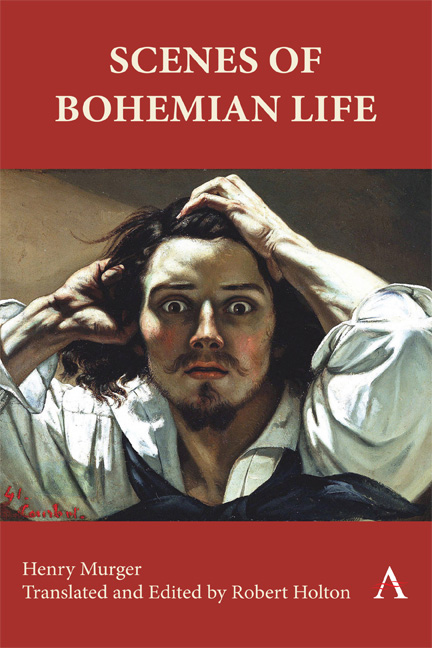Book contents
- Frontmatter
- Dedication
- Contents
- Introduction
- Chapter 1 How the Bohemian Society Was Established
- Chapter 2 A Gift from the Gods
- Chapter 3 Love at Lent
- Chapter 4 Ali-Rodolphe, or A Turk by Necessity
- Chapter 5 Charlemagne’s Coin
- Chapter 6 Mademoiselle Musette
- Chapter 7 The Sands of Pactolus
- Chapter 8 What Five Francs Can Cost
- Chapter 9 Polar Violets
- Chapter 10 The Cape of Storms
- Chapter 11 A Bohemian Café
- Chapter 12 A Reception in Bohemia
- Chapter 13 The Housewarming Party
- Chapter 14 Mademoiselle Mimi
- Chapter 15 Donec Gratus
- Chapter 16 The Passage of the Red Sea
- Chapter 17 The Graces Adorned
- Chapter 18 Francine’s Muff
- Chapter 19 Musette’s Whims
- Chapter 20 Mimi’s Fine Feathers
- Chapter 21 Romeo and Juliet
- Chapter 22 Epilogue to Love
- Chapter 23 Only Young Once
- Appendix: Murger’s Preface
- Notes
Introduction
Published online by Cambridge University Press: 01 March 2024
- Frontmatter
- Dedication
- Contents
- Introduction
- Chapter 1 How the Bohemian Society Was Established
- Chapter 2 A Gift from the Gods
- Chapter 3 Love at Lent
- Chapter 4 Ali-Rodolphe, or A Turk by Necessity
- Chapter 5 Charlemagne’s Coin
- Chapter 6 Mademoiselle Musette
- Chapter 7 The Sands of Pactolus
- Chapter 8 What Five Francs Can Cost
- Chapter 9 Polar Violets
- Chapter 10 The Cape of Storms
- Chapter 11 A Bohemian Café
- Chapter 12 A Reception in Bohemia
- Chapter 13 The Housewarming Party
- Chapter 14 Mademoiselle Mimi
- Chapter 15 Donec Gratus
- Chapter 16 The Passage of the Red Sea
- Chapter 17 The Graces Adorned
- Chapter 18 Francine’s Muff
- Chapter 19 Musette’s Whims
- Chapter 20 Mimi’s Fine Feathers
- Chapter 21 Romeo and Juliet
- Chapter 22 Epilogue to Love
- Chapter 23 Only Young Once
- Appendix: Murger’s Preface
- Notes
Summary
“… bohemia does not and cannot exist except in Paris.”
(“Murger's Preface” page 228)Most English-speaking readers, if they have heard of Henry Murger at all, will associate the name with Giacomo Puccini's beloved opera La Bohème or perhaps with Jonathan Larson's Broadway hit Rent. But despite the fact that these hugely popular works are adapted from Murger's 1851 Scènes de la vie de bohème (Scenes of Bohemian Life), Murger and his work are not well known and his book, unfortunately, has largely fallen into obscurity. Audiences might laugh with the bohemians as their exuberance and creative energy run up against middle-class resistance on stage and screen, they might warm to the famous love scenes that challenge the strictures of conventional sexual codes, and they might even shed a tear as Mimi lies dying in La Bohème or in Rent (almost). But for decades, Murger's book, the source of those scenes and a starting point for the many and varied bohemian subcultures that have sprung up ever since, has remained largely unread, in English at least. It is even included in a 2016 digital archive whose URL is forgottenbooks .co m. Most major urban centers have a bohemian district of some description, but few of the people who live, work or play there will be aware of the role that Murger and his book played in the development of these spaces.
It hasn't always been this way. By the early twentieth century, several English translations were available, a highly unusual response suggesting the remarkable level of interest the book had provoked. One American translation, for example, began to appear serially in The Knickerbocker in 1853, only two years after its publication in France, and at least six English translations were published over the next few decades. The most recent (Cameron) was published in 1949 and, while reprinted in 1960, it has long been out of print. For one reason or another, those translations have not aged well, are not easily available and no longer provide contemporary readers with a satisfying reading experience.
- Type
- Chapter
- Information
- Scenes of Bohemian Life , pp. 1 - 12Publisher: Anthem PressPrint publication year: 2023

